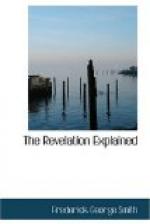As before stated (chap. 8:3), the heavenly world as opened up to John appeared symbolized after the sanctuary of the temple. By “the temple of the tabernacle of the testimony,” out of which the seven angels came fully prepared for their work, is meant the most holy place of the sanctuary, called “the tabernacle of the testimony” because there was deposited in it, beneath the wings of the cherubim, the ark of the testimony, or God’s covenant. It was therefore as from the most holy place of the sanctuary—from the very presence of the Deity—that these angels went forth commissioned to execute the seven last plagues. This shows that they went by the divine command as ministers of vengeance. The purity and beauty of their attire denoted both the spotless excellency of their characters and the justice of the work in which they were to engage. Although theirs was a work of awful avenging judgment, still the garments they wore would not be soiled thereby; and their flowing robes of white were girded up with a beautiful golden girdle. Therefore there is no inconsistency between the purity and love of God and the work of his vengeance. It would seem to human reasoning that the two are irreconcilable, but these symbols teach differently.
These angels received their vials (goblets) of wrath at the hands of one of the four living creatures, who are symbols of the redeemed sons of earth. Their deliverance by one of these doubtless denotes that these judgments were to be executed in their behalf and in answer to their prayers. For centuries the wrath of deadly persecutors had been poured out upon God’s people, until the cry ascended from the lips of the martyrs, “How long, O Lord, holy and true, dost thou not judge and avenge our blood on them that dwell on the earth?” Chap. 6:10. Now their prayer is answered, and by their hand, as it were, the vials of wrath are delivered with the divine sanction unto the seven angels to be poured out upon these proud oppressors of the Lord’s people. These vials, too, were “full of wrath.” What a fearful expression! Full of wrath, even “the wrath of God, who liveth forever and ever.” There was nothing in them but wrath and that to the very brim.
As soon as the vials were delivered, “the temple was filled with smoke from the glory of God.” This symbol is taken from the Shekinah which filled the ancient tabernacle. We read that when the tabernacle was finished, “a cloud covered the tent of the congregation, and the glory of the Lord filled the tabernacle. And Moses was not able to enter into the tent of the congregation, because the cloud abode thereon, and the glory of the Lord filled the tabernacle.” Ex. 40:34, 35. The same thing occurred at the dedication of Solomon’s temple. “The cloud filled the house of the Lord, so that the priests could not stand to minister because of the cloud: for the glory of the Lord had filled the house of the Lord.” 1 Kings 8:10, 11. So, also, in the symbol before us the glory of God filled the temple so that no man was able to enter. This is intended to set forth the fact that these avenging judgments were for the manifestation of the divine glory and that there was no access to the throne of God nor to his mercy-seat to alter them or to stay their execution. Such is the sublime scene presented to our view preparatory to the pouring out of the seven last great plagues.




